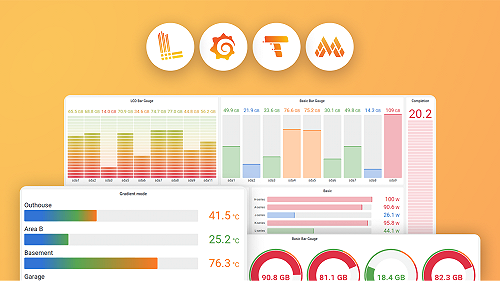Web Vitals
Web Vitals measure the real-world performance of your site so that developers, site owners, and others can improve it. For more information about Web Vitals, refer to web.dev.
The Web Vitals instrumentation uses the web-vitals package to collect and report data.
Tracking Web Vitals helps you to:
- Analyze the loading times of your pages
- Detect large repaints that take a lot of time
- Detect delays until first inputs from your users
How to use the Web Vitals instrumentation
The following Web Vitals instrumentation is enabled by default. No additional configuration is required.
initializeFaro({
url: 'https://my-domain.my-tld/collect/{app-key}',
app: {
name: 'my-app',
},
});Note
If you overwrite the
instrumentationsarray when you initialize the Grafana Faro Web SDK, you must manually include the Web Vitals instrumentation.
To manually include the Web Vitals instrumentation, use the following getWebInstrumentations helper function.
initializeFaro({
url: 'https://my-domain.my-tld/collect/{app-key}',
app: {
name: 'my-app',
},
instrumentations: [...getWebInstrumentations()],
});Alternatively, if you want to fine-tune which instruments are enabled, you can use the following WebVitalsInstrumentation class.
initializeFaro({
url: 'https://my-domain.my-tld/collect/{app-key}',
app: {
name: 'my-app',
},
instrumentations: [new WebVitalsInstrumentation()],
});How to capture Web Vitals attribution data
Web Vitals attribution data helps identify the elements and resources on a website that impact a specific web vital. By leveraging this data, you can find out what contributes to a bad web vital and reduce the time to repair by knowing where to look in your application.
Tracking attribution data is disabled by default.
To enable it, set trackWebVitalsAttribution: true in the Faro configuration.
initializeFaro({
url: 'https://my-domain.my-tld/collect/{app-key}',
app: {
name: 'my-app',
},
instrumentations: [new WebVitalsInstrumentation()],
trackWebVitalsAttribution: true,
});How to capture all Web Vital changes
In most cases, you want to capture web vital values only when the metric is ready to be reported.
However, it’s possible to report every change by setting reportAllChanges to true. For example, you can track each larger layout shift as it happens.
This feature can be useful when you are debugging, but in general it’s not necessary or recommended for measuring these metrics in production.
To capture all Web Vital changes, set reportAllChanges: true in the Faro configuration.
initializeFaro({
url: 'https://my-domain.my-tld/collect/{app-key}',
app: {
name: 'my-app',
},
instrumentations: [new WebVitalsInstrumentation()],
webVitalsInstrumentation: {
reportAllChanges: true,
},
});What data is included in each Web Vital measurement
Each measurement contains a metrics and a context object.
The metrics object contains measured values whereas the context object contains all other attributes.
Each Web Vital measurement contains a set of standard metrics as described below. For information about the additional metrics and attributes of a specific Web Vital, refer to the respective sections.
Shared measurements and attributes
Metrics object:
ttfb|cls|fcp|lcp|fid|inp|: the value of the respective web vital metricdelta: This is the delta between the current and the last-reported value. Thedeltaandclsare the same on the first report.
Context object (attributes):
id: the instance id of the metricrating: Rating about the threshold the metric is in, which is eithergood,needs improvement, orpoornavigation_type: the type of navigation, which isnavigate,reload,back-forward,back-forward-cache,prerender, orrestorenavigation_entry_id: the unique id of the navigation entry emitted by Faro’s performance instrumentation
Cumulative Layout Shift (CLS)
Metrics object:
The following measurements and attributes are additionally attached to the CLS event.
largest_shift_value: CLS score of the first element (document order) that shifted when the largest layout shift occurredlargest_shift_time: the time when the largest layout shift occurred
Context object (attributes):
largest_shift_target: the selector identifying the first element (document order) that shifted when the largest layout shift occurredload_state: loading state of the document, which isloading,dom-interactive,dom-content-loaded, orcomplete
First Contentful Paint (FCP)
The following measurements and attributes are additionally attached to the FCP event.
Metrics object:
first_byte_to_fcp: the delta between time to first byte (TTFB) and FCPtime_to_first_byte: the duration from making an HTTP request to the first byte received by the browser
Context object (attributes):
load_state: loading state of the document, which isloading,dom-interactive,dom-content-loaded, orcomplete
First Input Delay (FID)
The following measurements and attributes are additionally attached to the FID event.
Metrics object:
event_time: the time when the user interacted, which matches thetimeStampof the dispatchedevent
Context object (attributes):
event_target: the selector that identifies the element with which the user interacted. It is thetargetof the dispatchedevent.event_type: thetypeof theeventdispatched from the user interactionload_state: loading state of the document. Which isloading,dom-interactive,dom-content-loaded, orcomplete
Interaction to Next Paint (INP)
The following measurements and attributes are additionally attached to the INP event.
Metrics object:
interaction_time: the time when the user first interacted during the frame where the INP candidate interaction occurredpresentation_delay: the time from when the browser finishes processing all event listeners for user interaction until the next frame presents on the screeninput_delay: the time from when the browser finishes processing event listeners for user interaction until the next frame displays on the screenprocessing_duration: the time when the first event listener started running after a user interaction until when all event listener processing has been finishednext_paint_time: the best-guess timestamp of the next paint after the interaction
Context object (attributes):
load_state: loading state of the document, which isloading,dom-interactive,dom-content-loaded, orcompleteinteraction_target: the HTML element identified byinteractionTargetinteraction_type: the type of interaction, based on the event type of theevent, eitherpointer, orkeyboard
Largest Contentful Paint (LCP)
The following measurements and attributes are additionally attached to the LCP event.
Metrics object:
element_render_delay: the delta between the LCP resource has finished loading and the LCP element has been fully renderedresource_load_delay: the delta between TTFB and when the browser starts loading the LCP resource (otherwise 0)resource_load_duration: the time it takes to load the LCP resource (0 if there is none)
Context object (attributes):
element: the largest contentful paint element itself
Time to First Byte (TTFB)
The following measurements and attributes are additionally attached to the TTFB event.
dns_duration: the time to resolve the DNS for the requested domainconnection_duration: the time to create the connectionrequest_duration: the time between when the request was sent until the first byte of the response was receivedwaiting_duration: the time from user initiation to request handling startcache_duration: the time spent checking the HTTP cache
Context object (attributes): No additional attributes.



